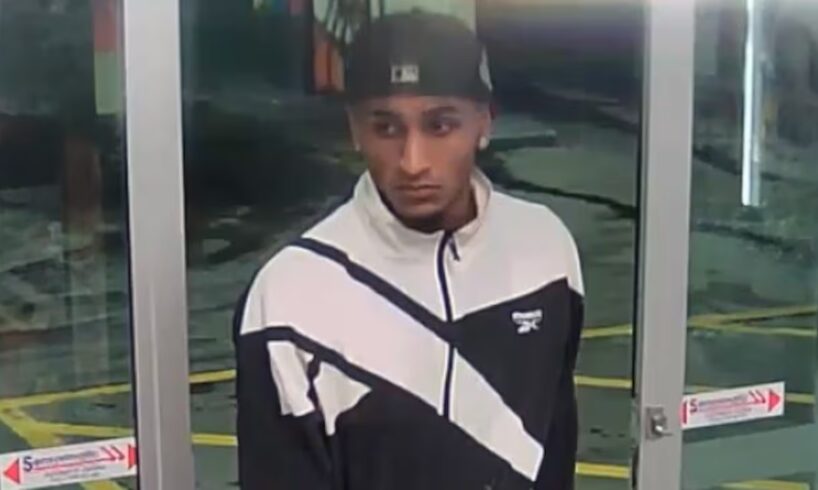
The 19-year-old, who also went by the hyphenated surname Mamfedos-Nair, would be reported missing by his mother days later.
But his body wouldn’t be found until nearly nine months later, when police finally found him at the Dairy Flat property where construction business owner Al Fadhli lived and kept digging equipment.
Police say this CCTV still of 19-year-old Jayden Mamfredos-Nair marked one of the last times he was seen alive in public. Photo / Police
“It was not easy at all to find Jayden – and it wasn’t meant to be,” McClintock said. “He had been buried by his killers three metres underground.”
Prosecutors described Mamfredos as a young dealer who got in over his head and unknowingly became a target after bragging of a large meth windfall to friends. Both he and long-time friend Snaylam, then a 19-year-old Head Hunters prospect, were starting to make their way in the criminal underworld, McClintock told jurors.
Snaylam, who had heard that Mamfredos had come into a quantity of methamphetamine probably worth six figures, allegedly pitched a plan for him and Mamfredos to pretend to sell 1kg of the product to a Black Power member. They would both show up with the meth but instead “gank” the buyer, taking his money and keeping the drugs, the two allegedly discussed via a Facebook Messenger conversation later uncovered by police.
“His willingness to trust Mr Snaylam … is ultimately the downfall of Mr Mamfredos,” McClintock said.
Matthew Snaylam appears in the High Court at Auckland on the first day of his murder trial. He is accused of having “double-crossed” friend Jayden Mamfredos, who was found dead in January 2024. Photo / Michael Craig
Prosecutors say evidence will show that Snaylam had a separate meeting with co-defendants Kameta, a patched Head Hunters member, and Al Fadhli, a Head Hunter associate, that same day. The men, both now 28, worked together in the construction industry and both were also involved in the drug trade, jurors were told.
In that meeting, they allegedly discussed the real plan to rob and kill Mamfedos – the Black Power buyer being a work of fiction to lure him to the rural property where the grave would be prepared.
Ultimately, it was location data that helped police find Mamfredos and arrest the trio, jurors were told today. The data suggested that Kameta and Snaylam picked up Mamfredos at Birdwood Reserve in Rānui, West Auckland, around 8.45pm on the day of the killing.
Al Fadhli, meanwhile, took his partner and her young children to the Auckland city centre for hours so that they wouldn’t witness what was about to occur, prosecutors said.
Mamfredos, Snaylam and Kameta appear to have turned off their phones several minutes after the pick-up, but unbeknownst to them, they were driving a work ute belonging to Al Fadhli that was equipped with GPS tracking. The vehicle arrived at the property around 9.10pm, and shortly thereafter, it is alleged, Memfredos was shot in the head.
Zak Huaki Kameta, described by prosecutors as a patched Head Hunters member, appears in the High Court at Auckland to stand trial for the alleged murder of teen methamphetamine dealer Jayden Mamfredos. Photo / Michael Craig
Seven minutes after the ute arrived at the property, data suggest it was moved about halfway down the driveway and stayed there for about 15 minutes. McClintock suggested that was so Snaylam could serve as lookout while Kameta, who worked in construction and knew how to operate a digger, buried the body.
The vehicle left the property at about 9.45pm. Snaylam and Kameta were seen on CCTV at a Z petrol station and a McDonald’s carpark a short time later. They ordered meals for just the two of them, McClintock said.
Al Fadhli, meanwhile, returned to his property with his family about an hour after the others left, prosecutors said. He called an employee that night and asked him to show up at the property early the next morning for an urgent matter, authorities said.
The next morning, McClintock explained, crushed concrete was spread over the grave and levelled with a roller vehicle.
Within less than a week, Kameta was described by prosecutors as “flush with cash” – having bought a Harley-Davidson motorcycle sight-unseen for $26,000 cash.
As police started to form a theory based on the location data and other information, they began to focus on the Dairy Flat property – searching it three times. They also received permission from the court to tap the defendants’ phones.
Hassan Al Fadhli appears in the High Court of Auckland, accused of providing his Dairy Flat property and digger to help in the murder of Jayden Mamfredos in April 2023. Photo / Michael Craig
During the first search, in May 2023, Al Fadhli allegedly instructed his partner to smash his cellphone and hide a gun. He also pretended, it is alleged, to call an employee to make a plan for the business. But police intercepted the call and now know he was tipping off Kameta, who soon thereafter went on the run, jurors were told.
But the body was “buried so deep and concealed so well that, like a needle in a haystack”, police couldn’t initially find it.
On a second search of the site in July that year, police found another covered-up hole that had been filled with rubbish. They didn’t realise it at the time, but investigators would later regard that hole as a test-run to see “how deep a grave to conceal Mr Mamfredos could be”.
“Little did they know as they searched through that pit … that Mr Mamfredos was less than two metres away,” McClintock said.
Police returned to the site for the final search in January 2024, armed with advice from a geo-forensics expert professor, who theorised that the first hole was a test grave. He outlined dig areas to prioritise and the body was located.
Police search a rural Dairy Flat property where the body of Jayden Mamfredos was found more than eight months after he was last seen alive. Photo / NZME
All three defendants were arrested a short time later.
As is required in court cases, their lawyers were allowed to respond today with only short statements of their own. More elaborate opening addresses will be allowed after the Crown finishes presenting its evidence.
Annabel Ives, representing Snaylam, and Ron Mansfield, KC, representing Kameta, both emphasised the circumstantial nature of the Crown’s case.
“There will be absolutely no evidence called by the Crown as to what happened at the crucial time when this man died,” Mansfield said, adding that Crown statements about Mamfredos being in over his head, a target and ultimately double-crossed are nothing but theories.
Ives noted that the Crown said her client had made a critical mistake on the night of the shooting when it appears he momentarily turned on his phone’s data – allowing it to be tracked – while at the Dairy Flat property.
“If there was this great plan, everyone was acting in concert, why on earth would he turn his phone on?” she asked. “There was no plan.”
Lawyer Justin Harder, representing Al Fadhi, said his client knew nothing of the plan or that there was a body on his property. Evidence will show it to be implausible that the first hole was a test grave, he suggested.
Detective Senior Sergeant Megan Goldie, the first and only witness to give evidence today, outlined the repeated efforts to find Mamfredos’ body at the Dairy Flat property.
Police search a Dairy Flat property in the missing persons investigation for Jayden Mamfredos-Nair, who was later found dead. Three men are now on trial, charged with murder. Photo / NZME
Within days of the missing person’s report, “it was looking worse and worse for Jayden’s welfare”, she said, noting that police were worried his social media and bank accounts hadn’t been touched. It also became clear, she said, that he had been involved in the drug trade so police started to wonder if it might have been a drug deal gone wrong.
They brought dogs to the property and ground-penetrating radar equipment, but came to believe that a digger might have been used. So they acquired their own digger, Goldie said.
In the first hole that police found in July, they discovered several bags of rubbish – including meat containers with expiry dates just weeks before Mamfredos went missing. The hole was exactly the dimensions of a digger bucket, she said.
So when they found another disturbed area of the soil of the same dimensions six months later, they immediately turned their attention to it and began digging a trench around it.
“We could see a shoe sticking out of the clay approximately three metres down in that area,” the detective said, explaining that after that point the work “slowed right down” and a trowel was used instead of a digger.
Police would later discover Mamfredos’ bank card in the pants pocket of the body and a cat buried in a foetal position next to him, she said.
The trial, scheduled to last five weeks, continues tomorrow before Justice Geoffrey Venning and the jury.
Craig Kapitan is an Auckland-based journalist covering courts and justice. He joined the Herald in 2021 and has reported on courts since 2002 in three newsrooms in the US and New Zealand.
Sign up to The Daily H, a free newsletter curated by our editors and delivered straight to your inbox every weekday.





